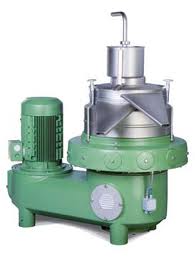Difference between revisions of "Solid Wall Separators"
(Created page with "Category:Separating{{Knoppen}} <noinclude><!------------------------------------------------ * READ THIS FIRST * Only edit this page if you can improve the content. * Improp...") |
|||
| Line 7: | Line 7: | ||
* Please start editing this page after the /noinclude | * Please start editing this page after the /noinclude | ||
* -------------------------------------------------></noinclude> | * -------------------------------------------------></noinclude> | ||
[[File:Solid Wall Separators_1.jpg|thumb|200px|right|Solid Wall Separators]] | |||
'''Solid Wall Separators''' are used almost exclusively for the separation of liquid mixtures with no or a very small solids content since the separated solids can only be removed manually. By fitting a large number of conical disks separated by spacers of between 0.3 to 2 mm, a substantially larger equivalent clarification area is achieved with the same bowl volume compared to chamber bowl separators. The equivalent clarification area is the product of the sum of the geometric surfaces of the disks multiplied with the multiple of the acceleration due to gravity. | |||
==Applications== | |||
*separate two liquids from each other, with low solids contents | |||
*separate one liquid form solids, clarifing liquid or recovering solids | |||
==Design and concept== | |||
The solid wall separator is designed to retain solids within the disc stack centrifuge and it is so called solids retaining separator. | |||
The solid wall bowl separator is often used in processes that require liquid/liquid or liquid/solids separation when the solids content in the feed is no more than about 1% by volume. Because of the simplicity of the design, very high g force can be obtained and this separator is thus very efficient in the recovery of fine particles. | |||
As with disk separators with self-cleaning bowl, the disc separator with solids wall bowl is not able to periodically discharge the separated solids at full speed. Because there is no hydraulic system. So, All solids separated out by a solids wall bowl shall be removed manually. | |||
==Video== | |||
<youtube>my7UWCGE1ds</youtube> | |||
Latest revision as of 05:32, 26 April 2013
Solid Wall Separators are used almost exclusively for the separation of liquid mixtures with no or a very small solids content since the separated solids can only be removed manually. By fitting a large number of conical disks separated by spacers of between 0.3 to 2 mm, a substantially larger equivalent clarification area is achieved with the same bowl volume compared to chamber bowl separators. The equivalent clarification area is the product of the sum of the geometric surfaces of the disks multiplied with the multiple of the acceleration due to gravity.
Applications
- separate two liquids from each other, with low solids contents
- separate one liquid form solids, clarifing liquid or recovering solids
Design and concept
The solid wall separator is designed to retain solids within the disc stack centrifuge and it is so called solids retaining separator.
The solid wall bowl separator is often used in processes that require liquid/liquid or liquid/solids separation when the solids content in the feed is no more than about 1% by volume. Because of the simplicity of the design, very high g force can be obtained and this separator is thus very efficient in the recovery of fine particles.
As with disk separators with self-cleaning bowl, the disc separator with solids wall bowl is not able to periodically discharge the separated solids at full speed. Because there is no hydraulic system. So, All solids separated out by a solids wall bowl shall be removed manually.
Video
